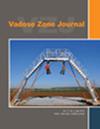Transport, dispersion, and degradation of nonpoint source contaminants during flood‐managed aquifer recharge
IF 2.8
3区 地球科学
Q3 ENVIRONMENTAL SCIENCES
引用次数: 0
Abstract
In water‐stressed regions of the world, the inundation of working landscapes to replenish aquifers—known as flood‐managed aquifer recharge (flood‐MAR)—has become a valuable tool for sustainable groundwater management. Due to their diverse land use histories, however, many potential recharge sites host nonpoint source contaminants (such as salts, pesticides, and fertilizers) within the vadose zone that may flush to groundwater during recharge operations. To identify the controls on contaminant migration, we perform stochastic simulations of flood‐MAR through a heterogeneous alluvial aquifer and apply transient particle tracking to evaluate conservative and reactive contaminant transport over 80 years of recharge operations. With semi‐annual recharge events, the water table begins to rise 0.13–1.84 years after the first inundation event while solutes take much longer (11 to 80 years) to transit the 45‐m thick unsaturated zone. We derive a parametric expression for the ratio of celerity (or rate of pressure transmission) to velocity of the flood‐MAR wetting front and show that this simplified expression agrees with values calculated from heterogeneous model simulations. Slow solute velocities (0.25–1.75 m year洪水管理含水层补给期间非点源污染物的迁移、扩散和降解
在世界上水资源紧张的地区,淹没正在耕作的土地以补充含水层--即洪水管理含水层补给(flood-MAR)--已成为可持续地下水管理的重要工具。然而,由于土地使用历史各不相同,许多潜在的补给地点的软弱带中都含有非点源污染物(如盐分、杀虫剂和化肥),这些污染物可能会在补给操作过程中冲入地下水。为了确定污染物迁移的控制因素,我们对通过异质冲积含水层的洪水-水文模拟进行了随机模拟,并应用瞬态颗粒跟踪技术评估了 80 年补给运行期间的保守和反应性污染物迁移。在半年一次的补给事件中,地下水位在第一次淹没事件后 0.13-1.84 年开始上升,而溶质则需要更长的时间(11 到 80 年)才能通过 45 米厚的非饱和带。我们推导出了洪水-海洋模式湿润前沿的流速(或压力传输速率)与速度之比的参数表达式,并表明这一简化表达式与异质模型模拟计算值一致。缓慢的溶质速度(0.25-1.75 米/年-1)允许通过反硝化作用大量清除污染物,但污染物羽流在此期间的扩散或稀释程度极低,会以锋面的形式到达地下水位。我们的研究结果表明,在洪水泥沙淤积期间,最大限度地降低地下水流速,最大限度地提高地下水流速,应能最大限度地增加供水量,同时限制水质恶化。
本文章由计算机程序翻译,如有差异,请以英文原文为准。
求助全文
约1分钟内获得全文
求助全文
来源期刊

Vadose Zone Journal
环境科学-环境科学
CiteScore
5.60
自引率
7.10%
发文量
61
审稿时长
3.8 months
期刊介绍:
Vadose Zone Journal is a unique publication outlet for interdisciplinary research and assessment of the vadose zone, the portion of the Critical Zone that comprises the Earth’s critical living surface down to groundwater. It is a peer-reviewed, international journal publishing reviews, original research, and special sections across a wide range of disciplines. Vadose Zone Journal reports fundamental and applied research from disciplinary and multidisciplinary investigations, including assessment and policy analyses, of the mostly unsaturated zone between the soil surface and the groundwater table. The goal is to disseminate information to facilitate science-based decision-making and sustainable management of the vadose zone. Examples of topic areas suitable for VZJ are variably saturated fluid flow, heat and solute transport in granular and fractured media, flow processes in the capillary fringe at or near the water table, water table management, regional and global climate change impacts on the vadose zone, carbon sequestration, design and performance of waste disposal facilities, long-term stewardship of contaminated sites in the vadose zone, biogeochemical transformation processes, microbial processes in shallow and deep formations, bioremediation, and the fate and transport of radionuclides, inorganic and organic chemicals, colloids, viruses, and microorganisms. Articles in VZJ also address yet-to-be-resolved issues, such as how to quantify heterogeneity of subsurface processes and properties, and how to couple physical, chemical, and biological processes across a range of spatial scales from the molecular to the global.
 求助内容:
求助内容: 应助结果提醒方式:
应助结果提醒方式:


